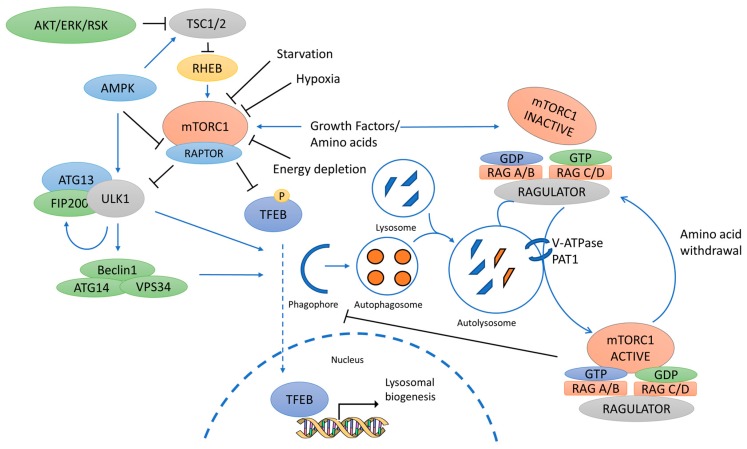Figure 1.
Schematic of key players in the mammalian autophagy pathway discussed in this review. The mechanistic target of rapamycin (mTORC1) is the major control complex for autophagy. A diverse range of signals, such as growth factors and amino acids, regulates mTORC1 by inhibiting the Tuberous sclerosis complex 1 and 2 (TSC1/2), thereby alleviating the inhibitory effect of TSC1/2 on the Ras homolog enriched in the brain (Rheb), which subsequently activates mTORC1. The AMP-activated protein kinase (AMPK) also inhibits mTORC1 via inhibition of the Regulatory associated protein of mTOR (Raptor). mTORC1 is tethered to the lysosomal surface via the Ras-related GTPases (Rags), which activity is regulated by the amino acid sensing of the the vacuolar H+-adenosine triphosphatase ATPase (v-ATPase) and the Proton-assisted amino acid transporter 1 (PAT1). Conversion of GTP-GDP is performed by the GTPase-activating proteins/ Guanine-exchange factor (GAP/GEF) activity of Folliculin (FLCN) and Ragulator. Under nutrient-rich conditions, mTORC1 suppresses autophagy by mediating phosphorylation-dependent inhibition of Unc-51 like autophagy activating kinase (ULK1) and the Transcription factor EB/E3 (TFEB/TFE3). Under starvation, ULK1 activation promotes autophagy initiation and autophagosome maturation, and TFEB/TFE3 promote transcription of genes regulating autophagy and lysosomal biogenesis.

